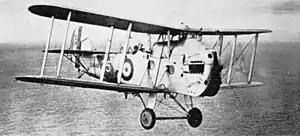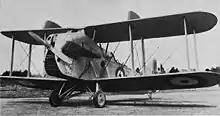| R.1 Blackburn | |
|---|---|
 | |
| Blackburn Blackburn II | |
| Role | Carrier-based reconnaissance |
| Manufacturer | Blackburn Aeroplane & Motor Company Limited |
| First flight | 1922 |
| Introduction | 1923 |
| Retired | 1931 |
| Primary user | Fleet Air Arm |
| Number built | 44 |
| Developed from | Blackburn T.2 Dart |
The Blackburn R-1 Blackburn was a 1920s British single-engine fleet spotter/reconnaissance aircraft built by Blackburn Aircraft.
History
The Blackburn was developed to meet a naval requirement (Specification 3/21) for a carrier-based reconnaissance aircraft and gun spotting aircraft. Blackburn designed a new fuselage and used the wing and tail surfaces from the Blackburn Dart. The pilot sat in an open cockpit above the engine, a navigator sat inside the fuselage and a gun position was located at the rear of the fuselage cabin. The aircraft's two-bay wings could fold for stowage aboard aircraft carriers, with the upper wing attached directly to the fuselage, which filled the interplane gap. Armament was a single forward-firing Vickers machine gun mounted externally to the left of the pilot, with a Lewis gun on a Scarff ring for the gunner.[1]
Three prototypes were flown during 1922, leading to an initial production contract for 12 aircraft.[2] The production aircraft were designated Blackburn I and the first deliveries to the Fleet Air Arm at Gosport began in April 1923. 18 more Blackburn Is were built in 1923–1924.[3] Its first operational deployment was with No. 422 Fleet Spotter Flight, which deployed aboard HMS Eagle in the Mediterranean in 1923.[4]
A further order was placed for 29 Blackburns with the more powerful Napier Lion V engine, designated the Blackburn II. The upper wing was raised 22½ in (0.57 m) to improve handling.[3] A few Blackburns were used as dual-control trainers and all the Blackburn Is were converted to II standard before the type became obsolete in 1931, when they were replaced by the Fairey IIIF.
Variants
- Blackburn
- Prototype, three built.
- Blackburn I
- Production version with a 449 hp (335 kW) Napier Lion IIB engines, 33 built.[4]
- Blackburn II
- Improved production version with a 464 hp (346 kW) Napier Lion V, and increased gap between wings. 29 built.[5]

- Blackburn Trainer
- Trainer version of Blackburn I, fitted with side-by-side cockpit and dual controls. Known by the Fleet Air Arm as the Bull. Two out of Blackburn I batch.[6]
Operators
Specifications (Blackburn I)
Data from British Naval Aircraft since 1912 [5]
General characteristics
- Crew: 3
- Length: 36 ft 2 in (11.02 m)
- Wingspan: 45 ft 6 in (13.87 m)
- Height: 12 ft 6 in (3.81 m)
- Wing area: 650 sq ft (60 m2)
- Empty weight: 3,929 lb (1,782 kg)
- Gross weight: 5,962 lb (2,704 kg)
- Max takeoff weight: 6,648 lb (3,015 kg)
- Powerplant: 1 × Napier Lion IIB W-12 water-cooled piston engine, 450 hp (340 kW)
Performance
- Maximum speed: 122 mph (196 km/h, 106 kn) at 3,000 ft (914 m)
- Endurance: 4 hours 15 minutes
- Service ceiling: 12,950 ft (3,950 m)
- Rate of climb: 690 ft/min (3.5 m/s)
Armament
- Guns: 2 × .303 in (7.7 mm) Lewis guns
See also
Aircraft of comparable role, configuration, and era
Related lists
References
- ↑ Jackson 1968, pp. 160–161.
- ↑ Jackson 1968, p. 162.
- 1 2 Jackson 1968, p. 164.
- 1 2 Thetford 1978, p. 48.
- 1 2 Thetford 1978, p. 49.
- ↑ Thetford 1978, p. 50.
- 1 2 Jackson 1968, pp. 169.